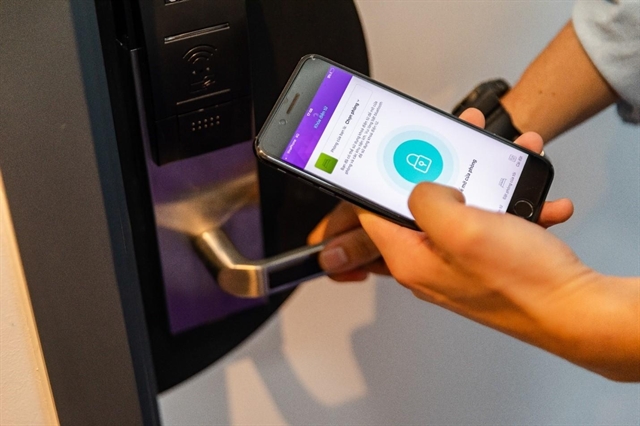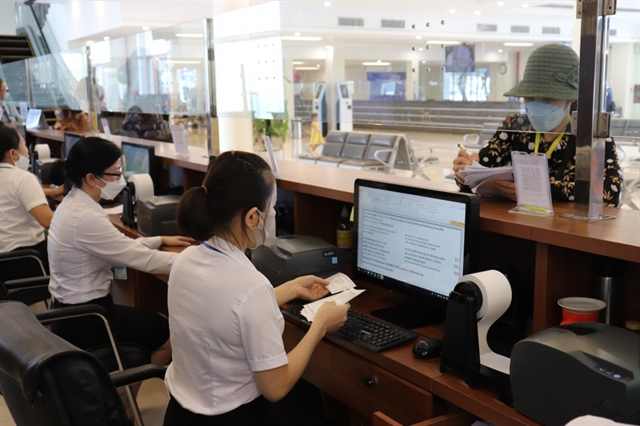Adapting to the pandemic, many services suppliers in Hạ Long City have gradually shifted to approaching customers online, implementing all transactions like booking, advertising and paying. The touch tourism trend has become popular.
Lê Hương
Like many other top tourist destinations in the country, Quảng Ninh has shown various signs of recovery in tourism industry, resulting from applying digital technology in developing products and diversifying visitor experiences.
Adapting to the pandemic, many services suppliers in Hạ Long City have gradually shifted to approaching customers online, implementing all transactions like booking, advertising and paying. The touch tourism trend has become popular.

Guests can use their smartphones to open rooms in SOJO Hotel Hạ Long. VNS Photo Vũ Thanh
SOJO Hotel Hạ Long is a pioneer in the field.
“We have applied the ‘no touch’' model through digital technology,” said Lê Tuấn Kiệt, director of SOJO Hotel Ha Long. “Visitors can download an app to book rooms, check-in and check out by themselves. They don’t need to meet any staff at our hotel.”
Kiệt said customers could control all devices in the room and the app, like changing music and the light theme for the room.
Online advertising
Various tourism promotion activities have been pushed on digital platforms.
The Quảng Ninh Tourism Promotion Centre has operated a page on Facebook to announce its information and promote local destinations. The site has nearly 30,000 followers.
The centre has also run English and French pages with constantly updated information.
The centre has also been responsible for publishing tourism information on websites, YouTube, Instagram, and Zalo platforms.
The province has run two websites, halongtourism.com.vn and discoverhalong.com, in three languages Vietnamese, English and Chinese, where visitors can search for information on destinations, services, entertainment, festivals, delicacies, hotels, resorts and shopping venues. The website also publishes digital tourism maps, a guide to book rooms online, and book cars and hotlines to contact when necessary.
Cô Tô District’s Culture and Information Department has recently live-streamed to introduce local tourism on open broadcast software and the Cô Tô – Quảng Ninh Tourism fan page.
“Audiences can see Cô Tô’s natural landscapes, delicacies and tourism services,” said Lê Thanh Toàn, a Hanoian. “I think this is a fresh way to enhance connections with potential visitors.”

A Viettel staff guides a local shop owner in Tuần Châu Island to install a non-cash payment app on smartphone. VNS Photo Vũ Thanh
“I have not been to Cô Tô Island yet. But after the Livestream, I plan to go there for a weekend with my friends,” he said.
Virtual museum
According to Đỗ Quyết Tiến, deputy director in charge of Quảng Ninh Museum, the museum has offered a virtual museum model so that people can visit it online. The museum can also be reached on Google Arts & Culture.

The Quảng Ninh Museum IT department always tries to apply the most modern technology in the museum and introduce the museum to various digital platforms. VNS Photo Vũ Thanh
Digital ticket & money
The Hạ Long Bay Management Board has applied a collective software for services and electronic receipts. Since June this year, the board has collected entrance tickets by scanning QR codes and internet banking. The electronic receipt is printed in both Vietnamese and English to make it easy for foreigners.
An automatic ticket-selling system will be installed soon in Tuần Châu International Tourist Ship Dock and Hạ Long International Ship Dock to facilitate tourists visiting Hạ Long Bay.
A model for a smart cashless street in the Tuần Châu Tourism Site has been implemented. In the meantime, there are over 100 free wifi hotspots in public areas like airports, bus stations, and tourist destinations.
A system of cameras has been set up in some crucial caves like Đầu Gỗ and Thiên Cung. Tourism shops in the area have installed GPS systems as well.

Digital tickets are printed for guests at Hạ Long International Ship Dock. VNS Photo Vũ Thanh
Lê Minh Tân, deputy director of the Quảng Ninh Tourism Department, confirmed that the sector would offer smart services like smart tourism cards, digital tourism maps, and tourism guide apps to visitors.
“We will also apply digital technology to manage local tourism, set up more digital tourism products by virtual reality technology, and digitalise destinations with 360 degree and 3D photo themes,” he said.
Tân said the agency was building a digital tourism exchange to offer another more effective channel for enterprises to introduce photos and tourism products.
“I think Quảng Ninh is now more modern and convenient than ever with wifi hot spots in public areas,” noted visitor Nguyễn Thành An from HCM City.
“However, the net is not as quick as I want. It ran slowly when I started searching for more information on some destinations. Maybe there were too many people using the wifi hot spot. I had to switch to my 4G service. The local authorities should improve it to suit visitor demands.”
The province received more than 9.7 million visitors in the first 10 months of this year, with the total income from tourism over US$843 million, a four-fold increase against the same period of last year.
The province expects to receive over 11 million visitors this year. VNS